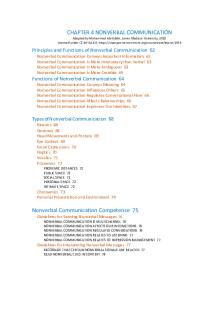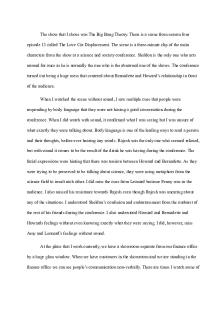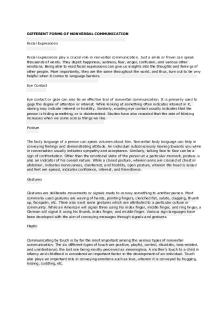CH 5 HW: Nonverbal Communication PDF

| Title | CH 5 HW: Nonverbal Communication |
|---|---|
| Course | Introduction To Human Communication |
| Institution | Suffolk County Community College |
| Pages | 2 |
| File Size | 56.2 KB |
| File Type | |
| Total Downloads | 4 |
| Total Views | 174 |
Summary
William O'Connell...
Description
1. Which statement below is NOT a main principal of nonverbal communication? a. Conveys emotional and relationship information b. Maintains a relationship with verbal messages c. Relies on context for its meaning d. Similarly used across cultures 2. John says goodbye and then waves at his grandchildren. This is an example of what function of nonverbal communication? a. Accenting b. Repeating c. Complementing d. Substituting 3. When a person uses a nonverbal behavior to augment a message while it is delivered such as knocking on a surface while saying “Knock on Wood” it is a function known as: a. Complementing b. Substituting c. Repeating d. Accenting 4. There are _____ different types of nonverbal communication. a. 7 b. 8 c. 6 d. 5 5. Which below is NOT an example of emblems? a. Pumping a fist b. Holding up one’s hand c. Shaking hands d. Furrowing your brow 6. Manifested emotion can be displayed in a variety of ways. This is known as _____. a. Adapting displays b. Affect displays c. Illustrator displays d. Complementing displays 7. People convey interest or lack of interest in another person, respect or disdain for the person or her or his message, and a host of other emotion, attitudes and thoughts with their eyes. This is referred to as_____. a. Proxemics b. Intimate distance c. Oculesics
d. None of the above 8. Task oriented people value promptness and like to do things in a linear fashion. They fall into the ____category. a. Polychronic b. Monochronic c. Bi-chronic d. Quadro-chronic 9. The volume of Jack’s voice was very quiet, inferring: a. He was not interested in the conversation b. He was angry c. He was shy d. Both A and C 10. Objects used to communicate information about yourself or others is the nonverbal communication known as: a. Artifacts b. Examples c. Detailed Attributes d. Commodities...
Similar Free PDFs

CH 5 HW: Nonverbal Communication
- 2 Pages

Ch 5 hw - ch 5
- 10 Pages

6 - Nonverbal Communication
- 1 Pages

Chapter 4 Nonverbal Communication
- 19 Pages

Ch. 5 Notes & HW
- 12 Pages

HW Ch 1 - HW Ch 1
- 3 Pages

Unit 5 hw - Hw assignment
- 3 Pages
Popular Institutions
- Tinajero National High School - Annex
- Politeknik Caltex Riau
- Yokohama City University
- SGT University
- University of Al-Qadisiyah
- Divine Word College of Vigan
- Techniek College Rotterdam
- Universidade de Santiago
- Universiti Teknologi MARA Cawangan Johor Kampus Pasir Gudang
- Poltekkes Kemenkes Yogyakarta
- Baguio City National High School
- Colegio san marcos
- preparatoria uno
- Centro de Bachillerato Tecnológico Industrial y de Servicios No. 107
- Dalian Maritime University
- Quang Trung Secondary School
- Colegio Tecnológico en Informática
- Corporación Regional de Educación Superior
- Grupo CEDVA
- Dar Al Uloom University
- Centro de Estudios Preuniversitarios de la Universidad Nacional de Ingeniería
- 上智大学
- Aakash International School, Nuna Majara
- San Felipe Neri Catholic School
- Kang Chiao International School - New Taipei City
- Misamis Occidental National High School
- Institución Educativa Escuela Normal Juan Ladrilleros
- Kolehiyo ng Pantukan
- Batanes State College
- Instituto Continental
- Sekolah Menengah Kejuruan Kesehatan Kaltara (Tarakan)
- Colegio de La Inmaculada Concepcion - Cebu








